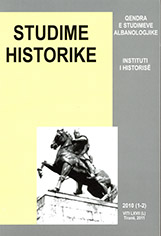Drishti në Mesjetë
Drishti during Middle Ages
Author(s): Edmond MalajSubject(s): History
Published by: Qendra e Studimeve Albanologjike
Keywords: Drishti ; Middle Ages; Albania; Albanian History
Summary/Abstract: Drishti (also called Drivasto during Middle Ages) stands around 12-13 km close to Shkodra, in the region of Postriba. This city's castle is thought to date from the Roman or the Illyrian times. During the early middle ages, the city has been part of the Byzantine Empire, during the second half of the 11th century it has been under the reign of Bodini of Dioclea, from 1185 Drishti fell in the hands of the Serbs and from 1393 to 1395 it was lorded by the Ottomans, but from 1396 the Benedicts took its reigns. Balsha II tried to occupy the city twice and on 1418 he caused great damage to the Drishtans. Later, and until 1442, Drishti was taken by the Serbian Despots. After the Despots, Drishti was under the jurisdiction of the Venetians until 1478. The same year it was occupied then by the Ottomans and afterwards it fell completely as a city. Drisht's population is composed by several ethnic minorities. We found there the Roman, the Albanian, even the Slav or Greek element. Some of the last names of the families in Drisht are for example: clearly Roman as: Palombo or Colomba, de Leporibus, etc; Albanian last names as: Bariloth, Precalo, Scapuder (1368 the first trace of the name of the Albanian people "Shqiptar"); Serbian last names as: Beroj, Svinja; or Greek ones as: Calageorgi and Spano (spanos = beardless). From an administrative point of view, the city had Vojvoda, which principally concerned 'the police' and the communal organization of the city. There was also Podestas (Podesta), which means owner, captain, a man with total power in an office, and it seems that this post was also known as "castellanus popolaris".
Journal: Studime Historike
- Issue Year: 2010
- Issue No: 01-02
- Page Range: 021-052
- Page Count: 32
- Language: Albanian
- Content File-PDF

